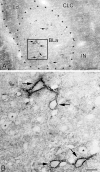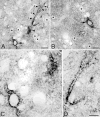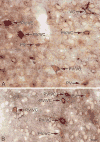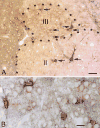Perineuronal nets labeled by monoclonal antibody VC1.1 ensheath interneurons expressing parvalbumin and calbindin in the rat amygdala
- PMID: 29094304
- PMCID: PMC5871560
- DOI: 10.1007/s00429-017-1542-8
Perineuronal nets labeled by monoclonal antibody VC1.1 ensheath interneurons expressing parvalbumin and calbindin in the rat amygdala
Abstract
Perineuronal nets (PNNs) are specialized condensations of extracellular matrix that ensheath particular neuronal subpopulations in the brain and spinal cord. PNNs regulate synaptic plasticity, including the encoding of fear memories by the amygdala. The present immunohistochemical investigation studied PNN structure and distribution, as well as the neurochemistry of their ensheathed neurons, in the rat amygdala using monoclonal antibody VC1.1, which recognizes a glucuronic acid 3-sulfate glycan associated with PNNs in the cerebral cortex. VC1.1+ PNNs surrounded the cell bodies and dendrites of a subset of nonpyramidal neurons in cortex-like portions of the amygdala (basolateral amygdalar complex, cortical nuclei, nucleus of the lateral olfactory tract, and amygdalohippocampal region). There was also significant neuropilar VC1.1 immunoreactivity, whose density varied in different amygdalar nuclei. Cell counts in the basolateral nucleus revealed that virtually all neurons ensheathed by VC1.1+ PNNs were parvalbumin-positive (PV+) interneurons, and these VC1.1+/PV+ cells constituted 60% of all PV+ interneurons, including all of the larger PV+ neurons. Approximately 70% of VC1.1+ neurons were calbindin-positive (CB+), and these VC1.1+/CB+ cells constituted about 40% of all CB+ neurons. Colocalization of VC1.1 with Vicia villosa agglutinin (VVA) binding, which stains terminal N-acetylgalactosamines, revealed that VC1.1+ PNNs were largely a subset of VVA+ PNNs. This investigation provides baseline data regarding PNNs in the rat which should be useful for future studies of their function in this species.
Keywords: Amygdala; Calcium-binding proteins; Extracellular matrix; Immunohistochemistry; Perineuronal nets.
Conflict of interest statement
Figures













References
-
- Abo T, Balch CM. A differentiation antigen of human NK and K cells identified by a monoclonal antibody (HNK-1) J Immunol. 1981;127:1024–1029. - PubMed
-
- Alpár A, Gärtner U, Härtig W, Brückner G. Distribution of pyramidal cells associated with perineuronal nets in the neocortex of rat. Brain Res. 2006;1120:13–22. - PubMed
-
- Baker KD, Gray AR, Richardson R. The development of perineuronal nets around parvalbumin gabaergic neurons in the medial prefrontal cortex and basolateral amygdala of rats. Behav Neurosci. 2017;131:289–303. - PubMed
MeSH terms
Substances
Grants and funding
LinkOut - more resources
Full Text Sources
Other Literature Sources

